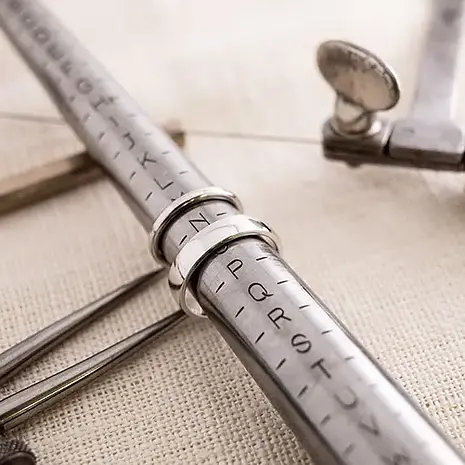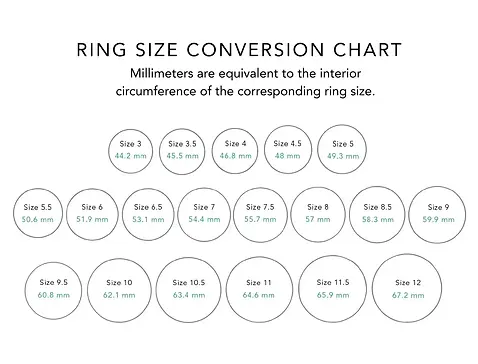
Ring Size Guide
Find your perfect fit with our easy, step-by-step methods.
How should a ring fit?
A ring that fits appropriately will slide over your knuckle with minimal friction and sit snugly on your finger without feeling too tight.
You should feel slight resistance but not need to apply too much force to take it on and off.
What to Do if You're in Between Ring Sizes
If you're in between ring sizes, we suggest sizing up rather than sizing down. Finger size can fluctuate throughout the day, and a ring that is too tight may not come over the knuckle easily, which can be painful. Additionally, there are simple, at-home ways to make a slightly loose ring feel tighter, but you'll need to consult a professional to size it up. Remember, if a half size doesn't feel quite right, contact us and we can craft a design in a quarter size to help you find the perfect fit.
Let our Experts Help you
Let us take the guesswork out of sizing. For the most precise fit, we invite you to visit our studio for a personal ring fitting—an experience as thoughtful as the love it represents.To ensure the perfect moment, we often recommend sizing slightly up, as fingers naturally expand when warm or excited. And if the fit isn’t just right after she says “yes,” rest assured, every engagement ring from Cherish & Co Bespoke Diamonds comes with a complimentary resize within one year.
Because love, like a ring, should feel just right.

Ring Size Tips
-
Our dominant hands are generally slightly larger – measure the hand you plan to wear the ring on.
-
Consider the design of your ring. Rings with wider bands will fit tighter. Plan to size up by at least a half size for chunky bands (>4mm) and size down accordingly for very thin designs (<1.3mm). Note that ring sizes are generally measured in millimeters (mm) and are not sized by inch.
-
Ensure your body temperature is normal – fingers tend to shrink when cold and expand when hot.
-
Fingers change size throughout the day based on the water we drink and the food we eat – the best time to measure is towards the middle or end of the day.
-
If your knuckle is pronounced, you may want to measure both the knuckle and the base of the finger. Then, choose a size in between those measurements as rings need to fit over the knuckle but not be too loose or tight to wear comfortably.
How to Measure an Existing Ring Size

What you'll need:
-
Printer & paper
-
String, yarn, floss, or a thin strip of paper
-
Pen or marker
-
Ruler
Steps:
1. Cut a piece of string, yarn, floss, or thin strip of paper to at least three inches long.
2. Wrap one end of the string around the base of the intended finger.
3. Using a pen or marker, mark where the end of the string overlaps with the rest.
4. Lay the string flat and use a ruler to measure the length between the end and your mark in millimeters.
5. Use the Ring Size Conversion Chart to match the millimeter length to the corresponding ring size.
Ring Size Chart
All of our rings are crafted in standard US sizes. View the chart below to see how US sizes map to finger circumference and convert to international sizes.
Engagement rings, wedding bands, and fashion rings all follow the same size format.
